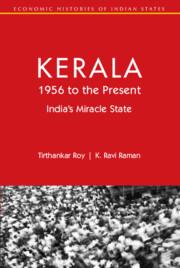Book contents
7 - The Left Legacy
Published online by Cambridge University Press: 31 May 2024
Summary
For years now, Kerala has had the distinction of being ruled by a communist-partyled coalition. The communist alliance won the first state assembly elections in 1957, lost in 1960, returned to power, and ruled the state in 1967–70 (first under E.M.S. Namboothiripad till 1969 and then under C. Achuthamenon), 1970–77, 1978–79 1980–81, 1987–91, 1996–2001, 2006– 11 and since 2016. In between, there were years when the state was under President's Rule, that is, the federal government governed it. The composition of the left coalition changed. It was never a body consisting of only the ideologically left parties: the Muslim League and some Christian factions allied with the communists. However, the main constituents of the coalition were the Communist Party of India (CPI) until 1964 and the CPI (Marxist), or CPI(M), after the CPI split into two parties.
In no other state of India, except West Bengal (and later Tripura), did the CPI or CPI(M) command a popular support base large enough to win elections. In common with West Bengal, tenants and agricultural labourers in these acutely land-scarce regions formed the main support base for the party. The communists won elections on the promise of land reforms. There was another historic factor behind their popularity. Caste equality movements coalesced around the leftist movement. Because of their commitment to the rural and land-dependent poor, the left delivered land reforms in Kerala and West Bengal in the 1970s. And in both states, ruling left parties indirectly drove private capital out of trade and industry. Ideological differences within the Communist Party of India led to a split in 1964. A faction led by S.A. Dange tended to have cooperation with the Indian National Congress, which then had a good relationship with the Soviet Union. That and the debates on National Bourgeoisie led to the split.
This is not a paradox. The paradox was that from the 1990s, if not earlier, the left quietly turned friendly towards private capital. By then, agriculture was in retreat, the old base of the left was not significant anymore, and the state was rapidly falling behind India in economic growth (and investment rates).
- Type
- Chapter
- Information
- Kerala, 1956 to the PresentIndia's Miracle State, pp. 119 - 133Publisher: Cambridge University PressPrint publication year: 2024



